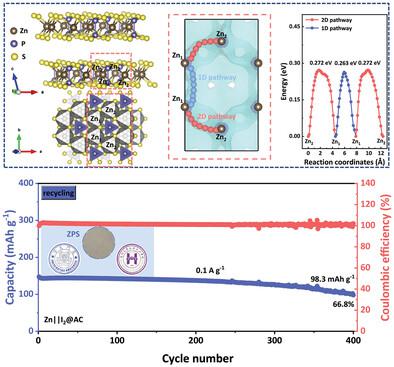当前位置:
X-MOL 学术
›
Adv. Funct. Mater.
›
论文详情
Our official English website, www.x-mol.net, welcomes your
feedback! (Note: you will need to create a separate account there.)
Stable Solid-State Zinc–Iodine Batteries Enabled by an Inorganic ZnPS3 Solid Electrolyte with Interconnected Zn2+ Migration Channels
Advanced Functional Materials ( IF 18.5 ) Pub Date : 2023-10-09 , DOI: 10.1002/adfm.202310476
Zeheng Lv 1 , Yuanhong Kang 1 , Guanhong Chen 1 , Jin Yang 1 , Minghui Chen 1 , Pengxiang Lin 1 , Qilong Wu 1 , Minghao Zhang 1 , Jinbao Zhao 1 , Yang Yang 1
Advanced Functional Materials ( IF 18.5 ) Pub Date : 2023-10-09 , DOI: 10.1002/adfm.202310476
Zeheng Lv 1 , Yuanhong Kang 1 , Guanhong Chen 1 , Jin Yang 1 , Minghui Chen 1 , Pengxiang Lin 1 , Qilong Wu 1 , Minghao Zhang 1 , Jinbao Zhao 1 , Yang Yang 1
Affiliation

|
Aqueous zinc–iodine (Zn–I2) batteries, with their outstanding merits in safety, cost, and environmental friendliness, have received extensive attention. However, the unstable electrochemistry at the electrode–electrolyte interface originating from free water results in zinc dendrite growth, hydrogen evolution reaction (HER), and polyiodide ions shuttle, hindering their practical applications. Herein, solid-state Zn–I2 batteries based on an inorganic ZnPS3 (ZPS) electrolyte are developed to overcome inherent interfacial issues associated with aqueous electrolytes. The inorganic ZnPS3 electrolyte, with a low Zn2+ diffusion energy barrier of ≈0.3 eV, demonstrates an exceptional ion conductivity of 2.0 × 10−3 S cm−1 (30 °C), which also satisfies high chemical/electrochemical stability and mechanical strength. The solid Zn2+ conduction mechanism, facilitated by bounded water only on grains, effectively suppresses HER and polyiodide ions shuttling. During cycling, a ZnS functional layer is spontaneously formed on the anode/electrolyte interphase, promoting dendrite-free Zn deposition behavior with a more stable (002) crystal orientation. Consequently, the solid-state configuration of Zn–I2 battery enables an impressive reversible capacity of 154.2 mAh g−1 after 400 cycles at 0.1 A g−1. Importantly, the compatibility of the solid-state ZnPS3 electrolyte is also confirmed in the Zn||CuS cell, indicating its potential as a versatile platform for developing inorganic solid-state zinc-ion batteries (ZIBs).
中文翻译:

由具有互连 Zn2+ 迁移通道的无机 ZnPS3 固体电解质实现的稳定固态锌碘电池
水系锌碘(Zn-I 2 )电池以其安全性、成本和环境友好等突出优点受到广泛关注。然而,由于自由水导致电极-电解质界面不稳定的电化学导致锌枝晶生长、析氢反应(HER)和聚碘离子穿梭,阻碍了其实际应用。在此,开发了基于无机ZnPS 3 (ZPS)电解质的固态Zn-I 2电池,以克服与水性电解质相关的固有界面问题。无机ZnPS 3电解质具有约0.3 eV的低Zn 2+扩散能垒,表现出2.0 × 10 -3 S cm -1 (30 °C)的优异离子电导率,同时满足高化学/电化学稳定性和机械强度。仅由颗粒上的束缚水促进的固体 Zn 2+传导机制有效地抑制了 HER 和聚碘离子的穿梭。在循环过程中,ZnS 功能层在阳极/电解质界面上自发形成,促进无枝晶的 Zn 沉积行为,并具有更稳定的 (002) 晶体取向。因此,Zn-I 2电池的固态配置在0.1 A g -1下循环400次后可实现令人印象深刻的154.2 mAh g -1可逆容量。重要的是,固态 ZnPS 3电解质的相容性也在 Zn||CuS 电池中得到证实,表明其作为开发无机固态锌离子电池 (ZIB) 的通用平台的潜力。
更新日期:2023-10-09
中文翻译:

由具有互连 Zn2+ 迁移通道的无机 ZnPS3 固体电解质实现的稳定固态锌碘电池
水系锌碘(Zn-I 2 )电池以其安全性、成本和环境友好等突出优点受到广泛关注。然而,由于自由水导致电极-电解质界面不稳定的电化学导致锌枝晶生长、析氢反应(HER)和聚碘离子穿梭,阻碍了其实际应用。在此,开发了基于无机ZnPS 3 (ZPS)电解质的固态Zn-I 2电池,以克服与水性电解质相关的固有界面问题。无机ZnPS 3电解质具有约0.3 eV的低Zn 2+扩散能垒,表现出2.0 × 10 -3 S cm -1 (30 °C)的优异离子电导率,同时满足高化学/电化学稳定性和机械强度。仅由颗粒上的束缚水促进的固体 Zn 2+传导机制有效地抑制了 HER 和聚碘离子的穿梭。在循环过程中,ZnS 功能层在阳极/电解质界面上自发形成,促进无枝晶的 Zn 沉积行为,并具有更稳定的 (002) 晶体取向。因此,Zn-I 2电池的固态配置在0.1 A g -1下循环400次后可实现令人印象深刻的154.2 mAh g -1可逆容量。重要的是,固态 ZnPS 3电解质的相容性也在 Zn||CuS 电池中得到证实,表明其作为开发无机固态锌离子电池 (ZIB) 的通用平台的潜力。

































 京公网安备 11010802027423号
京公网安备 11010802027423号